Alexandros Iosifidis
Department of Electrical and Computer Engineering, Aarhus University, Denmark
PRISM: Distributed Inference for Foundation Models at Edge
Jul 16, 2025Abstract:Foundation models (FMs) have achieved remarkable success across a wide range of applications, from image classification to natural langurage processing, but pose significant challenges for deployment at edge. This has sparked growing interest in developing practical and efficient strategies for bringing foundation models to edge environments. In this work, we propose PRISM, a communication-efficient and compute-aware strategy for distributed Transformer inference on edge devices. Our method leverages a Segment Means representation to approximate intermediate output features, drastically reducing inter-device communication. Additionally, we restructure the self-attention mechanism to eliminate redundant computations caused by per-device Key/Value calculation in position-wise partitioning and design a partition-aware causal masking scheme tailored for autoregressive models. We evaluate PRISM on ViT, BERT, and GPT-2 across diverse datasets, namely CIFAR-10, CIFAR-100, ImageNet-1k, GLUE, and CBT. Our results demonstrate substantial reductions in communication overhead (up to 99.2% for BERT at compression rate CR = 128) and per-device computation (51.24% for BERT at the same setting), with only minor accuracy degradation. This method offers a scalable and practical solution for deploying foundation models in distributed resource-constrained environments.
Variational Graph Convolutional Neural Networks
Jul 02, 2025Abstract:Estimation of model uncertainty can help improve the explainability of Graph Convolutional Networks and the accuracy of the models at the same time. Uncertainty can also be used in critical applications to verify the results of the model by an expert or additional models. In this paper, we propose Variational Neural Network versions of spatial and spatio-temporal Graph Convolutional Networks. We estimate uncertainty in both outputs and layer-wise attentions of the models, which has the potential for improving model explainability. We showcase the benefits of these models in the social trading analysis and the skeleton-based human action recognition tasks on the Finnish board membership, NTU-60, NTU-120 and Kinetics datasets, where we show improvement in model accuracy in addition to estimated model uncertainties.
Learning hidden cascades via classification
May 16, 2025Abstract:The spreading dynamics in social networks are often studied under the assumption that individuals' statuses, whether informed or infected, are fully observable. However, in many real-world situations, such statuses remain unobservable, which is crucial for determining an individual's potential to further spread the infection. While this final status is hidden, intermediate indicators such as symptoms of infection are observable and provide important insights into the spread process. We propose a partial observability-aware Machine Learning framework to learn the characteristics of the spreading model. We term the method Distribution Classification, which utilizes the power of classifiers to infer the underlying transmission dynamics. We evaluate our method on two types of synthetic networks and extend the study to a real-world insider trading network. Results show that the method performs well, especially on complex networks with high cyclic connectivity, supporting its utility in analyzing real-world spreading phenomena where direct observation of individual statuses is not possible.
Deep Reinforcement Learning-based Video-Haptic Radio Resource Slicing in Tactile Internet
Mar 18, 2025Abstract:Enabling video-haptic radio resource slicing in the Tactile Internet requires a sophisticated strategy to meet the distinct requirements of video and haptic data, ensure their synchronized transmission, and address the stringent latency demands of haptic feedback. This paper introduces a Deep Reinforcement Learning-based radio resource slicing framework that addresses video-haptic teleoperation challenges by dynamically balancing radio resources between the video and haptic modalities. The proposed framework employs a refined reward function that considers latency, packet loss, data rate, and the synchronization requirements of both modalities to optimize resource allocation. By catering to the specific service requirements of video-haptic teleoperation, the proposed framework achieves up to a 25% increase in user satisfaction over existing methods, while maintaining effective resource slicing with execution intervals up to 50 ms.
Continual Low-Rank Scaled Dot-product Attention
Dec 05, 2024Abstract:Transformers are widely used for their ability to capture data relations in sequence processing, with great success for a wide range of static tasks. However, the computational and memory footprint of their main component, i.e., the Scaled Dot-product Attention, is commonly overlooked. This makes their adoption in applications involving stream data processing with constraints in response latency, computational and memory resources infeasible. Some works have proposed methods to lower the computational cost of transformers, i.e. low-rank approximations, sparsity in attention, and efficient formulations for Continual Inference. In this paper, we introduce a new formulation of the Scaled Dot-product Attention based on the Nystr\"om approximation that is suitable for Continual Inference. In experiments on Online Audio Classification and Online Action Detection tasks, the proposed Continual Scaled Dot-product Attention can lower the number of operations by up to three orders of magnitude compared to the original Transformers while retaining the predictive performance of competing models.
MMA-DFER: MultiModal Adaptation of unimodal models for Dynamic Facial Expression Recognition in-the-wild
Apr 13, 2024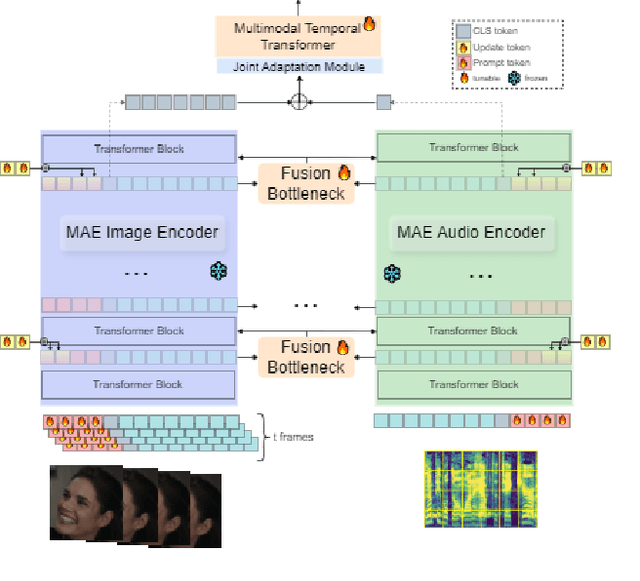
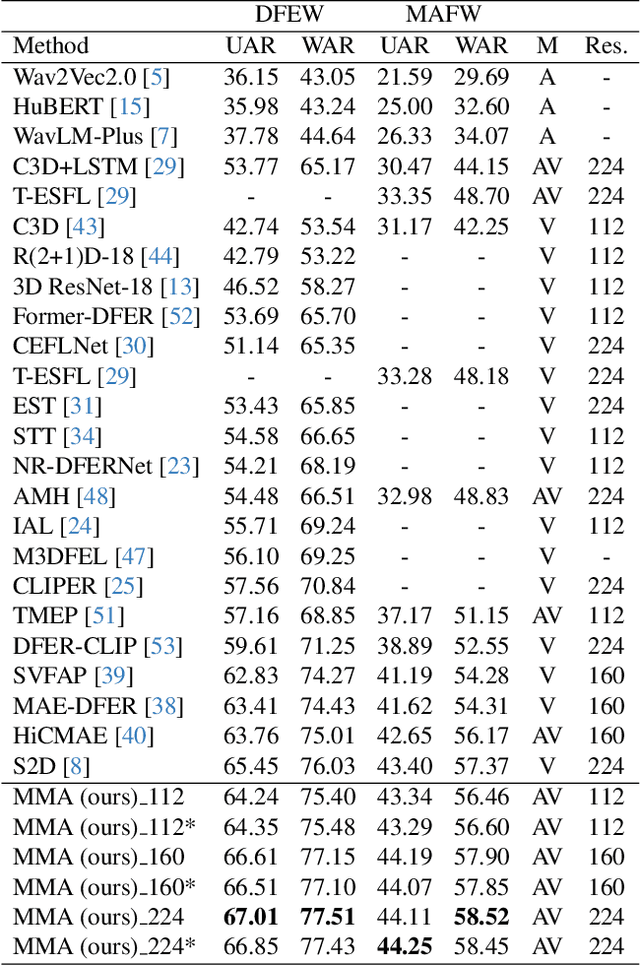
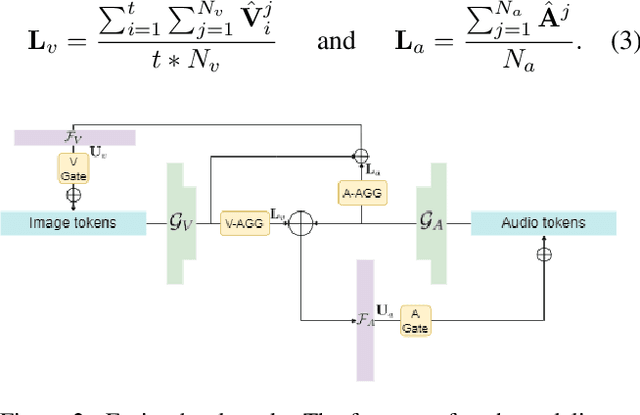

Abstract:Dynamic Facial Expression Recognition (DFER) has received significant interest in the recent years dictated by its pivotal role in enabling empathic and human-compatible technologies. Achieving robustness towards in-the-wild data in DFER is particularly important for real-world applications. One of the directions aimed at improving such models is multimodal emotion recognition based on audio and video data. Multimodal learning in DFER increases the model capabilities by leveraging richer, complementary data representations. Within the field of multimodal DFER, recent methods have focused on exploiting advances of self-supervised learning (SSL) for pre-training of strong multimodal encoders. Another line of research has focused on adapting pre-trained static models for DFER. In this work, we propose a different perspective on the problem and investigate the advancement of multimodal DFER performance by adapting SSL-pre-trained disjoint unimodal encoders. We identify main challenges associated with this task, namely, intra-modality adaptation, cross-modal alignment, and temporal adaptation, and propose solutions to each of them. As a result, we demonstrate improvement over current state-of-the-art on two popular DFER benchmarks, namely DFEW and MFAW.
Geometric Deep Learning for Computer-Aided Design: A Survey
Feb 27, 2024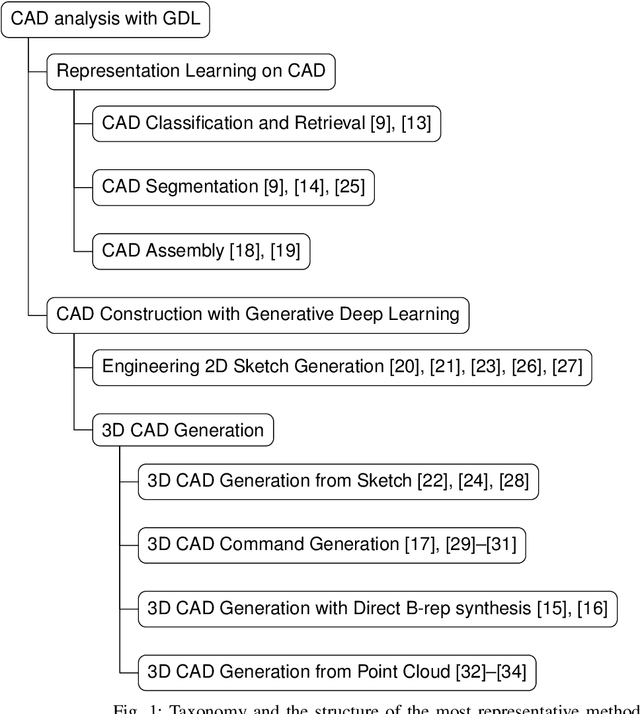

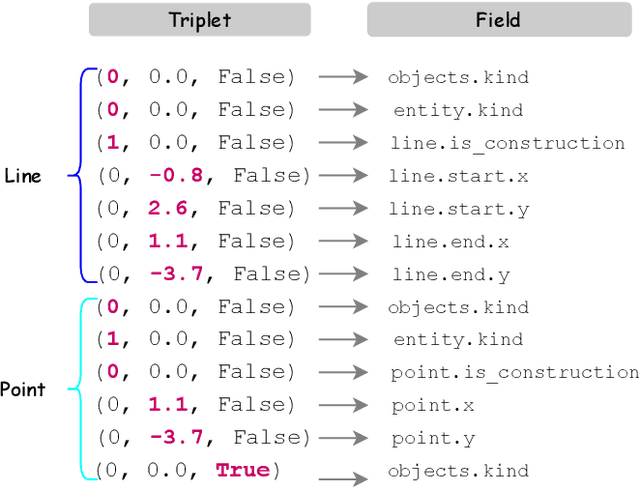
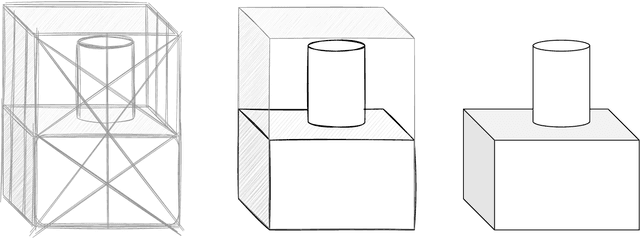
Abstract:Geometric Deep Learning techniques have become a transformative force in the field of Computer-Aided Design (CAD), and have the potential to revolutionize how designers and engineers approach and enhance the design process. By harnessing the power of machine learning-based methods, CAD designers can optimize their workflows, save time and effort while making better informed decisions, and create designs that are both innovative and practical. The ability to process the CAD designs represented by geometric data and to analyze their encoded features enables the identification of similarities among diverse CAD models, the proposition of alternative designs and enhancements, and even the generation of novel design alternatives. This survey offers a comprehensive overview of learning-based methods in computer-aided design across various categories, including similarity analysis and retrieval, 2D and 3D CAD model synthesis, and CAD generation from point clouds. Additionally, it provides a complete list of benchmark datasets and their characteristics, along with open-source codes that have propelled research in this domain. The final discussion delves into the challenges prevalent in this field, followed by potential future research directions in this rapidly evolving field.
Dynamic Semantic Compression for CNN Inference in Multi-access Edge Computing: A Graph Reinforcement Learning-based Autoencoder
Jan 19, 2024Abstract:This paper studies the computational offloading of CNN inference in dynamic multi-access edge computing (MEC) networks. To address the uncertainties in communication time and computation resource availability, we propose a novel semantic compression method, autoencoder-based CNN architecture (AECNN), for effective semantic extraction and compression in partial offloading. In the semantic encoder, we introduce a feature compression module based on the channel attention mechanism in CNNs, to compress intermediate data by selecting the most informative features. In the semantic decoder, we design a lightweight decoder to reconstruct the intermediate data through learning from the received compressed data to improve accuracy. To effectively trade-off communication, computation, and inference accuracy, we design a reward function and formulate the offloading problem of CNN inference as a maximization problem with the goal of maximizing the average inference accuracy and throughput over the long term. To address this maximization problem, we propose a graph reinforcement learning-based AECNN (GRL-AECNN) method, which outperforms existing works DROO-AECNN, GRL-BottleNet++ and GRL-DeepJSCC under different dynamic scenarios. This highlights the advantages of GRL-AECNN in offloading decision-making in dynamic MEC.
Multi-Class Anomaly Detection based on Regularized Discriminative Coupled hypersphere-based Feature Adaptation
Nov 24, 2023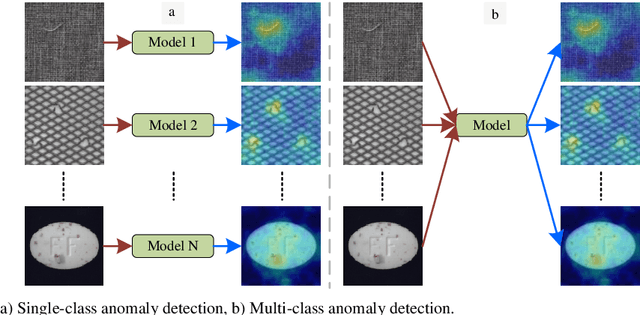
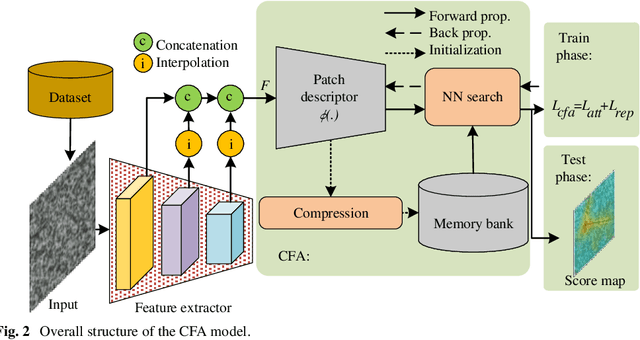
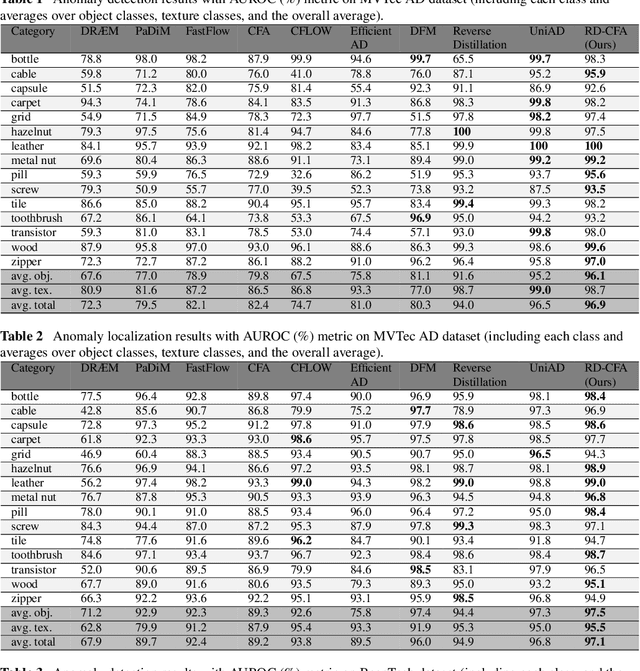
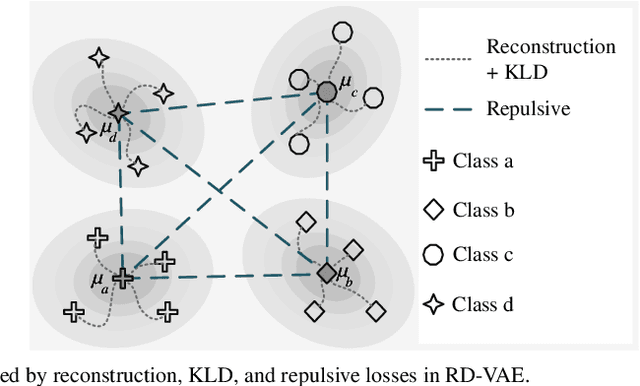
Abstract:In anomaly detection, identification of anomalies across diverse product categories is a complex task. This paper introduces a new model by including class discriminative properties obtained by a modified Regularized Discriminative Variational Auto-Encoder (RD-VAE) in the feature extraction process of Coupled-hypersphere-based Feature Adaptation (CFA). By doing so, the proposed Regularized Discriminative Coupled-hypersphere-based Feature Adaptation (RD-CFA), forms a solution for multi-class anomaly detection. By using the discriminative power of RD-VAE to capture intricate class distributions, combined with CFA's robust anomaly detection capability, the proposed method excels in discerning anomalies across various classes. Extensive evaluations on multi-class anomaly detection and localization using the MVTec AD and BeanTech AD datasets showcase the effectiveness of RD-CFA compared to eight leading contemporary methods.
Improving Unimodal Inference with Multimodal Transformers
Nov 16, 2023



Abstract:This paper proposes an approach for improving performance of unimodal models with multimodal training. Our approach involves a multi-branch architecture that incorporates unimodal models with a multimodal transformer-based branch. By co-training these branches, the stronger multimodal branch can transfer its knowledge to the weaker unimodal branches through a multi-task objective, thereby improving the performance of the resulting unimodal models. We evaluate our approach on tasks of dynamic hand gesture recognition based on RGB and Depth, audiovisual emotion recognition based on speech and facial video, and audio-video-text based sentiment analysis. Our approach outperforms the conventionally trained unimodal counterparts. Interestingly, we also observe that optimization of the unimodal branches improves the multimodal branch, compared to a similar multimodal model trained from scratch.
 Add to Chrome
Add to Chrome Add to Firefox
Add to Firefox Add to Edge
Add to Edge